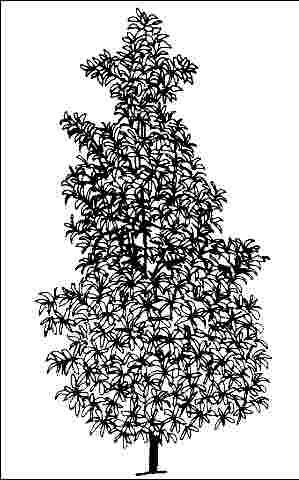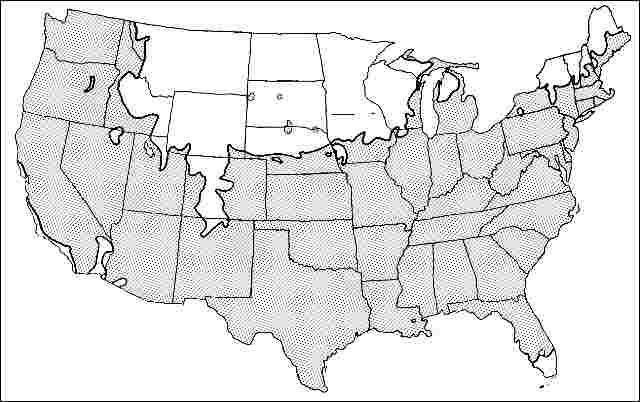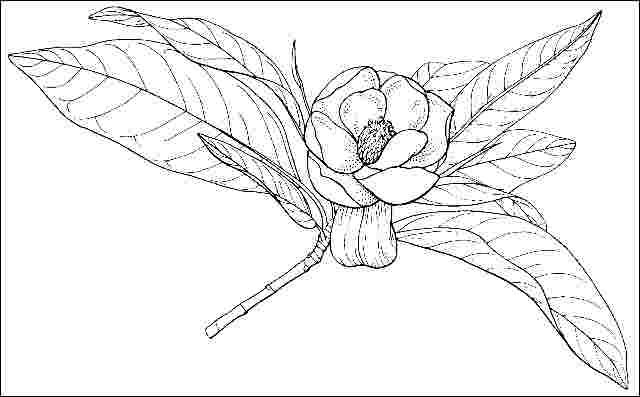Introduction
Magnolia virginiana `Henry Hicks' is a graceful southern evergreen with a wide columnar habit, ideal for use as a patio, tree, or specimen. It remains evergreen well into USDA hardiness zone 6, maybe 5b. It can grow to a mature height of 40 feet in the north or to 60 feet in the south. Trees glimmer in the wind due to the whitish-green undersides of the leaves. They are very noticeable as you drive by them on interstates along water-logged woodlands. The tree provides excellent vertical definition in a shrub border or as a free standing specimen and flourishes in moist, acid soil such as the swamps in the eastern U.S. and along stream banks. The creamy-white, lemon-scented flowers appear from June through September, and are followed by small red seeds which are used by a variety of wildlife. It can be trained into a multi-trunked, spreading specimen plant, or left with the central leader intact as a wide column.

General Information
Scientific name: Magnolia virginiana
Pronunciation: mag-NO-lee-uh ver-jin-ee-AY-nuh
Common name(s): 'Henry Hicks' Sweetbay Magnolia, `Henry Hicks' Swamp Magnolia
Family: Magnoliaceae
USDA hardiness zones: 5A through 9B (Fig. 2)
Origin: native to North America
Invasive potential: little invasive potential
Uses: deck or patio; specimen; street without sidewalk; espalier; tree lawn 4-6 feet wide; tree lawn > 6 ft wide; highway median
Availability: not native to North America

Description
Height: 40 to 50 feet
Spread: 15 to 25 feet
Crown uniformity: symmetrical
Crown shape: columnar, vase
Crown density: moderate
Growth rate: moderate
Texture: medium
Foliage
Leaf arrangement: alternate (Fig. 3)
Leaf type: simple
Leaf margin: entire
Leaf shape: elliptic (oval), oblong
Leaf venation: brachidodrome, pinnate
Leaf type and persistence: broadleaf evergreen, evergreen
Leaf blade length: less than 2 inches, 2 to 4 inches
Leaf color: green
Fall color: no color change
Fall characteristic: not showy

Flower
Flower color: white/cream/gray
Flower characteristics: very showy
Fruit
Fruit shape: elongated
Fruit length: 1 to 3 inches
Fruit covering: dry or hard
Fruit color: red, green
Fruit characteristics: attracts birds; showy; fruit/leaves not a litter problem
Trunk and Branches
Trunk/bark/branches: branches don't droop; showy; typically multi-trunked; thorns
Pruning requirement: little required
Breakage: resistant
Current year twig color: green
Current year twig thickness: thin
Wood specific gravity: unknown
Culture
Light requirement: full sun, partial sun or partial shade
Soil tolerances: clay; sand; loam; acidic; well-drained; extended flooding
Drought tolerance: moderate
Aerosol salt tolerance: low
Other
Roots: not a problem
Winter interest: no
Outstanding tree: no
Ozone sensitivity: unknown
Verticillium wilt susceptibility: susceptible
Pest resistance: resistant to pests/diseases
Use and Management
Sweetbay Magnolia makes an excellent tree for planting next to buildings, in narrow alleys or corridors, or in other urban areas with limited space for horizontal crown expansion. It has not been planted extensively in downtown urban areas, but its flood and drought tolerance and narrow crown combine to make it a good candidate. It usually maintains a good, straight central leader, although occasionally the trunk branches low to the ground forming a round multi-stemmed, spreading tree. Should be grown and planted more often.
Sweetbay Magnolia roots easily from softwood cuttings, grows freely near coastal areas, and is happiest in southern climates. It is thriving in the Auburn Shade Tree Evaluation trials in Alabama without irrigation. However, in the confined soil spaces typical of some urban areas, occasional irrigation is recommended.
The species is deciduous in USDA hardiness zones 7 and 8 (evergreen farther south) but the variety australis and cultivar 'Henry Hicks' are evergreen; 'Havener' has larger flower petals.
Pests and Diseases
Scales sometimes infest foliage and twigs, particularly on dry sites where the tree is under stress.
Tulip-Poplar weevil (sassafras weevil) feeds as a leaf miner when young and chews holes in the leaves as an adult.
Leaf spots occasionally occur on the foliage but are of little concern.